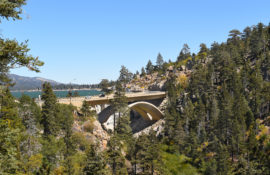
Did you know that Big Bear Lake is a man-made wonder? It was once revered as the “eighth wonder of the world.” Frank E. Brown began the construction of Big Bear’s first major dam in 1883, even though there were many who were skeptical of the project. In 1884, Brown finished the world’s largest man-made lake. The new dam was built in the year 1911 and this contributed to the increase of the size of the lake.
Many vacationers enjoy visiting the Big Bear Valley Historical Museum to learn about the colorful history and the diverse culture of Big Bear Valley. The Valley was once called Yuhaviat Valley. Yuhaviat is a Serrano Native American word which means “Pine Place.” The Native Americans who inhabited the area thousands of years ago called themselves the Yuhaviatam. But the Spanish settlers named the tribe “Serrano,” meaning “highlander.”
The Serranos are peace-loving people who believe that grizzly bears are their great grandfathers. For them, these huge animals are sacred. There were 30,000 Serrano people who resided in Big Bear Lake before Columbus, since then the Serrano population has declined. Today, there are about 200 tribe members left. The tribe still performs their sacred ceremonies around the area.
The Big Bear name came about in 1845 when Southern California land owner Benjamin Wilson and his men, chased after local Indians who had stolen horses from ranchers in Riverside, California. Some of Wilson’s men routed through the San Bernardino Mountains and discovered a high mountain valley heavily populated with grizzly bears. Because of the abundant population of grizzlies that once roamed the mountains, Wilson called the area Big Bear Valley.
Before Big Bear Lake became a famous four-season resort destination, it was once a gold mining mecca. The place has quite a history that will make your Big Bear Lake vacation just a little more meaningful.

